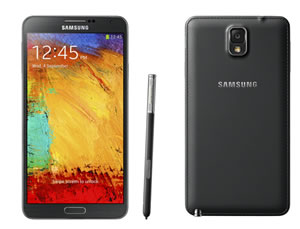Difference between Samsung Galaxy Note 3 and Note 2
Key difference: Samsung Galaxy Note 3 is the latest smartphone by the Samsung Corporation. It was unveiled on September 4, 2013, at the IFA Berlin with the Galaxy Gear, a smart watch that is supposed to work as a companion device for the Galaxy phones. The Galaxy Note 3 precedes the Note 2.

Samsung Galaxy Note 3 is the latest smartphone by the Samsung Corporation. It was unveiled on September 4, 2013, at the IFA Berlin to be launched on September 25, 2013. At the same event, Samsung also announced the launch of the Galaxy Gear, a smart watch that is supposed to work as a companion device for the Galaxy phones. The Gear will initially only be pairable with the Galaxy Note 3, however updates are expected soon that will make the watch compatible to Galaxy S3, S4 and Note 2.
The Gear has a 1.63-inch, 320x320-pixel super AMOLED screen in a metal screen. It can be used to answer calls, control music, etc. An app called the Gear Manager is used to control the settings on the Gear. The Gear also has a 1.9-megapixel embedded camera, which can be used for photos or video recording. The Gear will be launched with 60 available apps, which will grow over time. The Gear will be available in black, grey, beige, rose gold, green and orange.
The Note 3 itself is considered to be bigger, faster, thinner, and lighter than the Note 2. It features a 5.7 inch Super AMOLED display; an internal memory of 32 GB, which is expandable with a micro SD card of up to 64 GB; and 3G of RAM. The phone is available in two variants, which differ mainly in the processor. The LTE model is available with a 2.3 GHz Quad-Core Processor, whereas the 3G variant is available with a 1.9GHz Big-core Quad + a 1.3GHz little-core Quad. The phone also features a 13 MP primary camera, and a 2 MP primary front-facing camera. The Note 3 is also the first phone on the market to feature the new USB 3.0 charger.
In true Samsung fashion, the phone also boasts various features, such as the Air Command, which comes on each time the stylus is extracted. The menu can also be accessed through by hovering the stylus above the display and clicking its built-in button. The stylus can also be paired with various S Pen features, such as Action Memos, Pen Window, S Finder, and Scrapbook. The phone also continues the Multi Window functionality, as seen in Samsung's previous phones, such as the Samsung Galaxy Note II.
 The Samsung Galaxy Note II or Note 2 is a smartphone manufactured by Samsung and is an Android based device. The Note II is predeccesor of the Galaxy Note 3 and the successor of the Galaxy Note I. The Note II is known for its large display of 5.5 inches (141 mm), as well as its integral use of a stylus, called the S pen. The beauty of a Galaxy Note II is that it falls between the categories of a smartphone and a tablet. It is hence marketed as a ‘phablet’, a phone and a tablet, a hybrid or sorts.
The Samsung Galaxy Note II or Note 2 is a smartphone manufactured by Samsung and is an Android based device. The Note II is predeccesor of the Galaxy Note 3 and the successor of the Galaxy Note I. The Note II is known for its large display of 5.5 inches (141 mm), as well as its integral use of a stylus, called the S pen. The beauty of a Galaxy Note II is that it falls between the categories of a smartphone and a tablet. It is hence marketed as a ‘phablet’, a phone and a tablet, a hybrid or sorts.
In terms of hardware, the Note II features a 1.6 GHz quad-core processor, 720p resolution display, and 2 GB of RAM. The Note II is available in a variety of colors and in storage capacities of 16 GB, 32 GB and 64 GB. The phone also has an external expandable memory of up to 64 GB. The Galaxy Note II was launched with Android 4.1 (also called Jelly Bean) and at the time of its launch was the first phone to feature Android 4.1. Now, the phone is upgradeable to Android 4.1.2. The Note II also has easy usability because of the pen, which the users can use to write or draw on the phablet like it was paper.
Comparison between Samsung Galaxy Note 3 and Samsung Galaxy Note 2:
The information for the detailed table about the two phones has been taken from the Samsung website and GSMArena.com.
|
|
Samsung Galaxy Note 3 |
Samsung Galaxy Note II |
|
Launch Date |
September 25, 2013 |
September 2012 |
|
Company |
Samsung Corporation |
Samsung Corporation |
|
Size |
151.2 x 79.2 x 8.3mm |
151.1 x 80.5 x 9.4 mm (5.95 x 3.17 x 0.37 in) |
|
Display |
5.7 inch (144.3mm) Full HD Super AMOLED |
5.5 inches, super AMOLED capacitive touchscreen, 16M colors |
|
Screen |
1920 x 1080, 16M colors (~386 ppi pixel density) |
720 x 1280 pixels, (~267 ppi pixel density) |
|
Protection |
- |
Corning Gorilla Glass 2 |
|
Weight |
168g |
183 g (6.46 oz) |
|
2G Network |
GSM / GPRS / EDGE : 850 / 900 / 1800 / 1900 MHz |
GSM 850 / 900 / 1800 / 1900 |
|
3G Network |
HSPA+ 42Mbps: 850 / 900 / 1900 / 2100 MHz |
HSDPA 850 / 900 / 1900 / 2100 HSDPA 850 / 900 / 2100 - N7105 |
|
4G Network |
LTE Cat 4 150 /50Mbps: up to 6 different band sets (Dependent on market) |
LTE 800 / 900 / 1800 / 2600 - N7105 |
|
GUI |
TouchWiz UI |
TouchWiz UI |
|
CPU speed |
LTE: 2.3 GHz Quad-Core Processor 3G: 1.9GHz Big-core Quad + 1.3GHz little-core Quad |
Quad-core 1.6 GHz Cortex-A9 |
|
GPU |
LTE: Adreno 330 |
Mali-400MP |
|
OS |
Android OS, v4.3 (Jelly Bean) |
Android OS, v4.1.1 (Jelly Bean), upgradeable to 4.1.2 (Jelly Bean) |
|
Chipset |
Qualcomm Snapdragon 800 |
Exynos 4412 Quad |
|
RAM |
3 GB RAM |
2 GB RAM |
|
SIM Size |
Micro-SIM |
Micro-SIM |
|
Internal Memory |
32 GB |
16/32/64 GB |
|
Expandable Memory |
Micro SD (Up to 64GB) |
up to 64 GB |
|
Sensors |
Gesture Sensor, Accelerometer, Geo-magnetic, Gyro-sensor, Light Sensor, Proximity Sensor, Barometer Sensor/Temperature & Humidity Sensor, Hall Sensor |
Accelerometer, gyro, proximity, compass, barometer |
|
Connectivity |
WiFi 802.11 a / b / g / n / ac (HT80), GPS / GLONASS, NFC, Bluetooth v 4.0 (LE), IR LED (Remote Control), MHL 2.0 |
Bluetooth v 4.0 (Apt-X Codec support) LE, USB 2.0 Host, WiFi 802.11 a/b/g/n (2.4 & 5 GHz), Wi-Fi HT40, Wi-Fi Direct, NFC, S Beam, Samsung AllShare Play & Control, Samsung AllShare Cast (WiFi Display), Mirroring & Extention, Samsung AllShare Framework |
|
Data |
GPRS, EDGE, Speed, WLAN, Bluetooth, NFC, Infrared port, USB |
WiFi, NFC, GPRS, EDGE, LTE (4G), USB |
|
Speed |
HSDPA, 42 Mbps; HSUPA; LTE, Cat4, 50 Mbps UL, 150 Mbps DL |
HSDPA, 42 Mbps; HSUPA, 5.76 Mbps; LTE, Cat3, 50 Mbps UL, 100 Mbps DL |
|
WLAN |
WiFi 802.11 a/b/g/n/ac (HT80) |
Wi-Fi 802.11 a/b/g/n, dual-band, DLNA, Wi-Fi Direct, Wi-Fi hotspot |
|
Bluetooth |
Bluetooth 4.0 (LE) |
Bluetooth v4.0 with A2DP, LE, EDR |
|
USB |
microUSB v3.0 (MHL 2), USB Host |
microUSB v2.0 (MHL), USB Host |
|
Primary Camera |
13 MP, 4128 x 3096 pixels, autofocus, LED flash |
8 MP, 3264x2448 pixels, autofocus, LED flash |
|
Secondary Camera |
2 MP, 1080p@30fps |
1.9 MP |
|
Video |
2160p@30fps, 1080p@60fps (LTE model)/ 1080p@30fps (3G model) |
1080p@30fps |
|
Camera Features |
|
|
|
Sound Enhancement |
Active noise cancellation with dedicated mic |
SNS integration Active noise cancellation with dedicated mic |
|
Audio supported formats |
Codec, MP3, AAC/AAC+/eAAC+, WMA, FLAC, AMR-NB/WB, Vorbis, WAV |
MP3/WAV/eAAC+/AC3/FLAC player |
|
Video supported formats |
Code, H.264, MPEG-4, H.263, VC-1WMV7, WMV8, Sorenson Spark, MP43, VP8 |
MP4/DivX/XviD/WMV/H.264/H.263 player |
|
Battery Capacity |
Li-ion 3,200 mAh |
Li-ion 3,100 mAh |
|
Available Colors |
Black, White, Pink |
Titanium Gray, Marble White, Amber Brown, Ruby Wine, Pink |
|
Messaging |
SMS(threaded view), MMS, Email, Push Mail, IM, RSS |
SMS(threaded view), MMS, Email, Push Mail, IM, RSS |
|
Browser |
HTML5 |
HTML5 |
|
Radio |
- |
Stereo FM radio with RDS (N7100 only) |
|
GPS |
with A-GPS support and GLONASS |
with A-GPS support and GLONASS |
|
Java |
via Java MIDP emulator |
Java MIDP emulator |
|
Additional Features |
|
|
Image Courtesy: phandroid.com, allthingsd.com









Add new comment